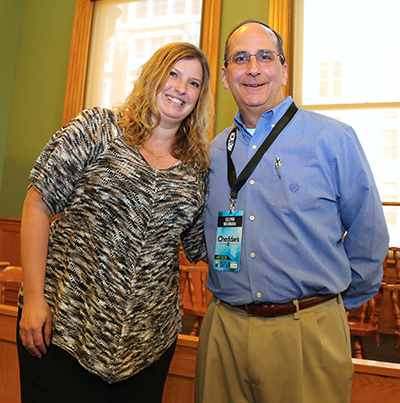Technological tools are increasingly helping restaurant operators recruit and retain employees in a tightening labor market, but experts say a human layer to the digital approach remains a significant part of the equation.
“Recruiting technology will continue to evolve to look more like marketing technology,” said Kevin P. Walker, an Austin, Texas-based business-to-business marketing expert. Job hunters are increasingly open to technological pitches, he noted.
A total of 44 percent of adult workers in general subscribe to websites that send job alerts on openings, Walker said, citing Harris poll data during a seminar at the recent Meeting of the Minds conference in Dallas hosted by Self Opportunity recruitment consultancy.
But until recently, technology hasn’t played a large role in restaurant hiring and retention practices, according to study released Tuesday by WorkJam, a Montreal-based employee relationship management platform.
About 57 percent of restaurants still rely on manual processes when scheduling employees, a survey of 500 U.S. service managers and 700 U.S. hourly workers found. Those processes led to frustration on the part of the employees, with 56 percent of employees surveyed saying they received their schedules a week or less in advance.
Response to scheduling
A line cook at a family-dining restaurant in Michigan City, Mich., told Nation’s Restaurant News about his frustrations with his schedules and the general manager.
The line cook said that his general manager played favorites when scheduling work hours, he wrote in an email to NRN. “I've been there six months and go to work every day. I have never called off one day. I work for other people, I do everything in the kitchen and I'm good at it.”
He said that restaurant staff is often scared to speak up about concerns because they are afraid to lose their jobs, "but somebody needs to stand up for what's right.”
Unpredictable and inconsistent scheduling practices affect not only retention, but the ability to recruit new workers.
The WorkJam survey, entitled “An Inside Look at the Hiring and Scheduling Crisis in the Hourly Workforce,” found that 46 percent of restaurants reported frequently or sometimes being understaffed. Of those, 53 percent said it compromised the customer experience.
The result was often both dissatisfied guests and employees.
More than a third of restaurants report a quarterly turnover rate of at least 26 percent for their hourly employees, and 33 percent claim that this rate has increased over the past two years.
“To maintain growth and minimize costs in today’s tough regulatory environment and competitive marketplace, businesses must quickly adopt more comprehensive systems to manage the employer-employee relationship,” Joshua Ostrega, co-founder and chief operating office of WorkJam, said in a statement.
“Managers need to realize that investing in better ways of hiring, scheduling and managing employees is an investment in the company’s bottom line,” Ostrega added.
In August 2014, Starbucks Corp., which has long been known for its enlightened and often cutting-edge employee practices, smacked head-on with the darker side of automated scheduling when The New York Times reported challenges some employees were having with scheduling software.
Last year, Starbucks said it immediately made significant changes in its automated scheduling, including getting rid of widely split shifts, known as “clopening,” when an employee is scheduled to close a unit at night and open it the next morning.
Clopenings are surprisingly common in the restaurant industry. The WorkJam survey found that 48 percent of managers schedule employees for back-to-back closing and opening shifts.
Last year, Starbucks also said schedules would be posted at least a week in advance, and workers who lived more than an hour’s commute from their current location would be relocated to closer units.
But in September, a survey of Starbucks employees by advocacy group The Center for Public Democracy found continued worker scheduling concerns including unpredictable work weeks, inconsistent schedules and clopening shifts.
“We’re the first to admit we have work to do,” Starbucks spokesperson Jaime Riley told the New York Times. “But we feel like we’ve made good progress, and that doesn’t align with what we’re seeing.” Despite the survey’s assertions, Starbucks told the New York Times that employees receive their schedules 10 days in advance.
Hiring costs
The cost of hiring and retraining workers has produced various estimates. The Institute for Research on Labor and Employment at the University of California–Berkeley noted in a 2010 working paper that average replacement costs for an individual worker averaged about $4,000 overall, and about $2,000 for blue collar and manual labor workers. Costs were as high as $7,000 for professional and managerial employees.
To help stem some of those costs, some restaurant chains are incorporating recruitment into their scheduling applications, most often accessible by the workers’ own smartphones or other computer devices.
“When the team members click in on their Hot Schedules [online platform for scheduling], a post comes up to talk about the referral program,” said Glenn Neuman, talent manager with the 160-unit Cheddar’s Casual Cafe, based in Irving, Texas. Cheddar’s referral program features staggered bonuses for recommended hires.

Cheddar’s is also working with existing platforms like Facebook and advertising potential job openings on entertainment websites like Pandora, of which about 80 percent of users of that site access it via mobile device.
“In May, we signed on with Pandora,” Neuman said. “A high percentage of Pandora users are using the free version where they get the audio ads. They create the audio ad for you. You can do a 15-second or 30-second ad, then a banner comes up on the device or the desktop. They click on that, and it takes them to your company website.”
Cheddar’s had no hard numbers on the response to the Pandora effect, Neuman said, as the company does not have a way to monitor it yet through the applicant tracking system. “For the first two ads that ran for 30 days, we had a couple thousand clicks,” Neuman said.
Cheddar’s and other restaurants also use ads on websites like Craigslist.
Neuman also said operators are getting really creative and working with nearby establishments to provide options for potential employees who might be seeking more hours than being offered at one restaurant.
“Smart operators are getting out there and not just sharing team members but really pulling together,” he said, adding that one restaurant could offer day shifts and another nearby restaurant could offer an evening slot.
WorkJam’s study found that 60 percent of hourly employees said the most difficult part of the job search was finding positions that fit their schedule and that were located close to home.
In addition, it found that 26 percent of hourly employees left their last hourly job because their schedule was inconsistent or it conflicted with other commitments. From the managers’ perspective, 68 percent of respondents said the most difficult part of scheduling was assigning shifts that accommodated both staff availability and business needs.
“Flexibility is the most important function for our managers,” Neuman said.
He said many units still use distinctly non-tech “Now Hiring” banners outside restaurants and flyers in nearby neighborhoods, along with technological tools.
Christine Blount, also a Cheddar’s talent manager, said some of the lowest-tech tools provide the biggest return.
“At one of our restaurants, we even put up a hot air balloon over a holiday weekend,” Blount said. “It brought in a number of applicants, as well as a few guests.”
Update: Oct. 21, 2015 This story has been updated to clarify the source and focus of the Harris poll data.
Contact Ron Ruggless at [email protected].
Follow him on Twitter: @RonRuggless

